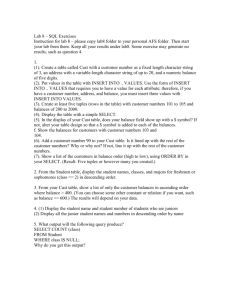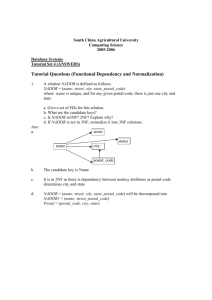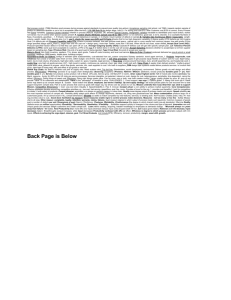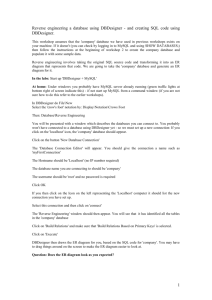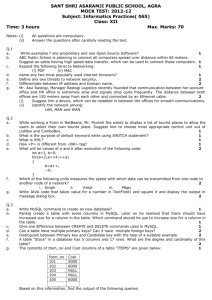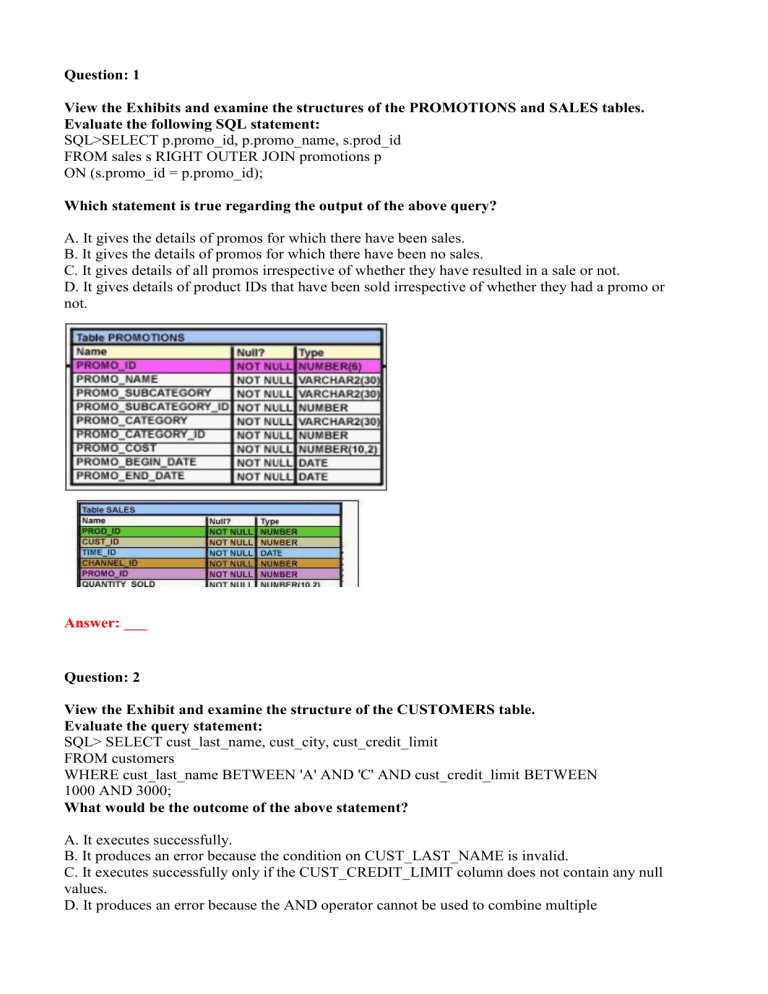
Question: 1
View the Exhibits and examine the structures of the PROMOTIONS and SALES tables.
Evaluate the following SQL statement:
SQL>SELECT p.promo_id, p.promo_name, s.prod_id
FROM sales s RIGHT OUTER JOIN promotions p
ON (s.promo_id = p.promo_id);
Which statement is true regarding the output of the above query?
A. It gives the details of promos for which there have been sales.
B. It gives the details of promos for which there have been no sales.
C. It gives details of all promos irrespective of whether they have resulted in a sale or not.
D. It gives details of product IDs that have been sold irrespective of whether they had a promo or
not.
Answer: ___
Question: 2
View the Exhibit and examine the structure of the CUSTOMERS table.
Evaluate the query statement:
SQL> SELECT cust_last_name, cust_city, cust_credit_limit
FROM customers
WHERE cust_last_name BETWEEN 'A' AND 'C' AND cust_credit_limit BETWEEN
1000 AND 3000;
What would be the outcome of the above statement?
A. It executes successfully.
B. It produces an error because the condition on CUST_LAST_NAME is invalid.
C. It executes successfully only if the CUST_CREDIT_LIMIT column does not contain any null
values.
D. It produces an error because the AND operator cannot be used to combine multiple
BETWEEN clauses.
Answer: __
Question: 3
Which two statements are true regarding the USING and ON clauses in table joins? (Choose
two.)
A. Both USING and ON clauses can be used for equijoins and nonequijoins.
B. A maximum of one pair of columns can be joined between two tables using the ON clause.
C. The ON clause can be used to join tables on columns that have different names but
compatible data types.
D. The WHERE clause can be used to apply additional conditions in SELECT statements
containing the ON or the USING clause.
Answer: ____
Question: 4
Where can subqueries be used? (Choose all that apply.)
A. field names in the SELECT statement
B. the FROM clause in the SELECT statement
C. the HAVING clause in the SELECT statement
D. the GROUP BY clause in the SELECT statement
E. the WHERE clause in only the SELECT statement
F. the WHERE clause in SELECT as well as all DML statements
Answer: ________
Question: 5
Using the CUSTOMERS table, you need to generate a report that shows 50% of each credit
amount in each income level. The report should NOT show any repeated credit amounts in each
income level. Which query would give the required result?
A. SELECT cust_income_level, DISTINCT cust_credit_limit * 0.50
FROM customers;
B. SELECT DISTINCT cust_income_level, DISTINCT cust_credit_limit * 0.50
AS "50% Credit Limit"
FROM customers;
C. SELECT DISTINCT cust_income_level || ' ' || cust_credit_limit * 0.50
AS "50% Credit Limit"
FROM customers;
D. SELECT cust_income_level ||' '|| cust_credit_limit * 0.50 AS "50% Credit Limit"
FROM customers;
Answer: ___
Question: 6
Which statement is true regarding the UNION operator?
A. By default, the output is not sorted.
B. NULL values are not ignored during duplicate checking.
C. Names of all columns must be identical across all SELECT statements.
D. The number of columns selected in all SELECT statements need not be the same.
Answer: ____
Question: 7
Which two statements are true regarding working with dates? (Choose two.)
A. The default internal storage of dates is in the numeric format.
B. The default internal storage of dates is in the character format.
C. The RR date format automatically calculates the century from the SYSDATE function and does
not allow the user to enter the century.
D. The RR date format automatically calculates the century from the SYSDATE function but
allows the user to enter the century if required.
Answer: ____
Question: 8
The ORDERS table belongs to the user OE. OE has granted the SELECT privilege on the
ORDERS table to the user HR. Which statement would create a synonym ORD so that HR can
execute the following query successfully?
SELECT * FROM ord;
A. CREATE SYNONYM ord FOR orders; This command is issued by OE.
B. CREATE PUBLIC SYNONYM ord FOR orders; This command is issued by OE.
C. CREATE SYNONYM ord FOR oe.orders; This command is issued by the database
administrator.
D. CREATE PUBLIC SYNONYM ord FOR oe.orders; This command is issued by the database
administrator.
Answer: ___
Question: 9
View the Exhibit and examine the structure of the PROMOTIONS table.
Which SQL statements are valid? (Choose all that apply.)
A. SELECT promo_id, DECODE(NVL(promo_cost,0), promo_cost,
promo_cost * 0.25, 100) "Discount"
FROM promotions;
B. SELECT promo_id, DECODE(promo_cost, 10000,
DECODE(promo_category, 'G1', promo_cost *.25, NULL),
NULL) "Catcost"
FROM promotions;
C. SELECT promo_id, DECODE(NULLIF(promo_cost, 10000),
NULL, promo_cost*.25, 'N/A') "Catcost"
FROM promotions;
D. SELECT promo_id, DECODE(promo_cost, >10000, 'High',
<10000, 'Low') "Range"
FROM promotions;
Answer: _____
Question: 10
Evaluate the following SQL statement:
SQL> SELECT cust_id, cust_last_name
FROM customers
WHERE cust_credit_limit IN
(select cust_credit_limit
FROM customers
WHERE cust_city ='Singapore');
Which statement is true regarding the above query if one of the values generated by the
subquery is NULL?
A. It produces an error.
B. It executes but returns no rows.
C. It generates output for NULL as well as the other values produced by the subquery.
D. It ignores the NULL value and generates output for the other values produced by the
subquery.
Answer: ___
Question: 11
View the Exhibit and examine the structure of the PRODUCTS table.
You need to generate a report in the following format:
CATEGORIES
--------------------------------------------5MP Digital Photo Camera's category is Photo
Y Box's category is Electronics
Envoy Ambassador's category is Hardware
Which two queries would give the required output? (Choose two.)
A. SELECT prod_name || q'''s category is ' || prod_category CATEGORIES
FROM products;
B. SELECT prod_name || q'['s ]'category is ' || prod_category CATEGORIES
FROM products;
C. SELECT prod_name || q'\'s\' || ' category is ' || prod_category CATEGORIES
FROM products;
D. SELECT prod_name || q'<'s >' || 'category is ' || prod_category CATEGORIES
FROM products;
Answer: ___
Question: 12
The PART_CODE column in the SPARES table contains the following list of values:
PART_CODE
----------------A%_WQ123
A%BWQ123
AB_WQ123
Evaluate the following query:
SQL> SELECT part_code
FROM spares
WHERE part_code LIKE '%\%_WQ12%' ESCAPE '\';
Which statement is true regarding the outcome of the above query?
A. It produces an error.
B. It displays all values.
C. It displays only the values A%_WQ123 and AB_WQ123.
D. It displays only the values A%_WQ123 and A%BWQ123.
E. It displays only the values A%BWQ123 and AB_WQ123.
Answer: ___
Question: 13
When does a transaction complete? (Choose all that apply.)
A. when a DELETE statement is executed
B. when a ROLLBACK command is executed
C. when a PL/SQL anonymous block is executed
D. when a data definition language (DDL) statement is executed
E. when a TRUNCATE statement is executed after the pending transaction
Answer: _____
Question: 14
Which two statements are true regarding single row functions? (Choose two.)
A. They accept only a single argument.
B. They can be nested only to two levels.
C. Arguments can only be column values or constants.
D. They always return a single result row for every row of a queried table.
E. They can return a data type value different from the one that is referenced.
Answer: _____
Question: 15
View the Exhibit to examine the description for the SALES and PRODUCTS tables.
You want to create a SALE_PROD view by executing the following SQL statement:
CREATE VIEW sale_prod
AS SELECT p.prod_id, cust_id, SUM(quantity_sold) "Quantity", SUM(prod_list_price) "Price"
FROM products p, sales s
WHERE p.prod_id=s.prod_id
GROUP BY p.prod_id, cust_id;
Which statement is true regarding the execution of the above statement?
A. The view will be created and you can perform DML operations on the view.
B. The view will be created but no DML operations will be allowed on the view.
C. The view will not be created because the join statements are not allowed for creating a view.
D. The view will not be created because the GROUP BY clause is not allowed for creating a view.
Answer: ____
Question: 16
View the Exhibit and examine the description for the CUSTOMERS table.
You want to update the CUST_INCOME_LEVEL and CUST_CREDIT_LIMIT columns for the
customer with the CUST_ID 2360. You want the value for the CUST_INCOME_LEVEL to have
the same value as that of the customer with the CUST_ID 2560 and the CUST_CREDIT_LIMIT
to
have the same value as that of the customer with CUST_ID 2566.
Which UPDATE statement will accomplish the task?
A. UPDATE customers
SET cust_income_level = (SELECT cust_income_level
FROM customers
WHERE cust_id = 2560),
cust_credit_limit = (SELECT cust_credit_limit
FROM customers
WHERE cust_id = 2566)
WHERE cust_id=2360;
B. UPDATE customers
SET (cust_income_level,cust_credit_limit) = (SELECT
cust_income_level, cust_credit_limit
FROM customers
WHERE cust_id=2560 OR cust_id=2566)
WHERE cust_id=2360;
C. UPDATE customers
SET (cust_income_level,cust_credit_limit) = (SELECT
cust_income_level, cust_credit_limit
FROM customers
WHERE cust_id IN(2560, 2566)
WHERE cust_id=2360;
D. UPDATE customers
SET (cust_income_level,cust_credit_limit) = (SELECT
cust_income_level, cust_credit_limit
FROM customers
WHERE cust_id=2560 AND cust_id=2566)
WHERE cust_id=2360;
Answer: ____
Question: 17
View the Exhibit and examine the structure of the PROMOTIONS table.
Evaluate the following SQL statement:
SQL>SELECT promo_category, AVG(promo_cost) Avg_Cost, AVG(promo_cost)*.25
Avg_Overhead
FROM promotions
WHERE UPPER(promo_category) IN ('TV', 'INTERNET','POST') GROUP BY Avg_Cost ORDER
BY
Avg_Overhead;
The above query generates an error on execution. Which clause in the above
SQL statement causes the error?
A. WHERE
B. SELECT
C. GROUP BY
D. ORDER BY
Answer: _____
Question: 18
Which statement is true regarding subqueries?
A. The LIKE operator cannot be used with single-row subqueries.
B. The NOT IN operator is equivalent to IS NULL with single-row subqueries.
C. =ANY and =ALL operators have the same functionality in multiple-row subqueries.
D. The NOT operator can be used with IN, ANY, and ALL operators in multiple-row subqueries.
Answer: ____
Question: 19
View the Exhibits and examine the structures of the PRODUCTS, SALES, and CUSTOMERS
tables.
You need to generate a report that gives details of the customer's last name, name of the
product, and the quantity sold for all customers in 'Tokyo'.
Which two queries give the required result? (Choose two.)
A. SELECT c.cust_last_name,p.prod_name, s.quantity_sold
FROM sales s JOIN products p
USING(prod_id)
JOIN customers c
USING(cust_id)
WHERE c.cust_city='Tokyo';
B. SELECT c.cust_last_name, p.prod_name, s.quantity_sold
FROM products p JOIN sales s JOIN customers c
ON(p.prod_id=s.prod_id)
ON(s.cust_id=c.cust_id)
WHERE c.cust_city='Tokyo';
C. SELECT c.cust_last_name, p.prod_name, s.quantity_sold
FROM products p JOIN sales s
ON(p.prod_id=s.prod_id)
JOIN customers c
ON(s.cust_id=c.cust_id)
AND c.cust_city='Tokyo';
D. SELECT c.cust_id,c.cust_last_name,p.prod_id, p.prod_name, s.quantity_sold
FROM products p JOIN sales s
USING(prod_id)
JOIN customers c
USING(cust_id)
WHERE c.cust_city='Tokyo';
Answer: ____
Question: 20
Which three SQL statements would display the value 1890.55 as $1,890.55?
(Choose three.)
A. SELECT TO_CHAR(1890.55,'$0G000D00')
FROM DUAL;
B. SELECT TO_CHAR(1890.55,'$9,999V99')
FROM DUAL;
C. SELECT TO_CHAR(1890.55,'$99,999D99')
FROM DUAL;
D. SELECT TO_CHAR(1890.55,'$99G999D00')
FROM DUAL;
E. SELECT TO_CHAR(1890.55,'$99G999D99')
FROM DUAL;
Answer: _____
